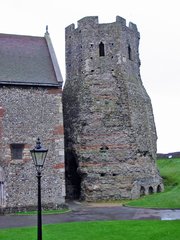Dover Castle
|
|
Dover Castle is situated in Kent and has been described as the "Key to England" due to its defensive significance throughout history.
| Contents |
Early fortifications
Originally fortified (earthworks) by native Britons before the Romans invaded in AD43, It was built near the site of an 80-foot high Roman lighthouse (or Pharos), which still survives.
The first castle was probably a Saxon fort, but after the Battle of Hastings, William the Conqueror improved the fortifications, building a motte and bailey design castle.
Henry II's castle
It was during the reign of Henry II that the castle began to take recognisable shape. The inner bailey and the great Keep belong to this time.
The siege of 1216
In 1216, a group of rebel barons had invited Louis VIII of France to come and take the English crown. Canterbury, Rochester and London had already fallen to Louis, and King John's forces were besieged by Prince Louis at Dover. The constable of the castle, Hubert de Burgh had successfully defended the castle at Chinon in 1205 and he had a well-supplied garrison of men.
The siege began on 19 July. Louis' men successfully undermined the barbican and attempted to topple the castle gate, but De Burgh's men managed to repulse the invaders, blocking the breach in the walls with giant timbers.
DoverCastle-bailey-2004-10-03.jpg
After three months spent besieging the castle, Louis called a truce on 14 October and soon after returned to London. However the Dover garrison repeatedly disrupted his communication with France, and Louis returned to Dover to begin a second siege on 12 May 1217. However, with many of his men involved in the siege, he suffered heavy defeats in the Battle of Lincoln on 20 May 1217. After another defeat at the Battle of Sandwich, Louis gave up his claim on the English throne. Dover Castle had stood firm.
The secret tunnels
The fortifications were improved over the centuries. Massive rebuilding took place during the Napoleonic Wars, including the expansion of underground tunnels to serve as barracks.
During the Second World War the underground tunnels were converted into an underground hospital and a military command centre from where the Dunkirk evacuations were masterminded. Later the tunnels were to be used as a shelter for regional government in the event of a nuclear attack (this plan was abandoned when it was realised the chalk of the cliffs would not provide significant protection from radiation). Tunnel levels were denoted as A - Annexe, B - Bastion, C - Casemate, D - DUMPY and E - Esplanade. Annexe and Casemate levels are open to the public, Bastion is 'lost' but investigations continue to gain access, DUMPY (converted from WW2 use to serve as a Regional Seat of Government in event of an atomic war) is closed, as is Esplanade (last used as air raid tunnel shelters in WW2).
The castle today
The castle, secret tunnels and surrounding land is now owned by English Heritage and the site is a major tourist attraction. The Lord Warden of the Cinque Ports is officially head of the castle.
References
- Goodall, John, "Dover Castle and the Great Siege of 1216 (http://www.deremilitari.org/RESOURCES/ARTICLES/goodall.htm)", Chateau Gaillard v.19 (2000) (the online version lacks the diagrams of the print version)

